Honoring Ourselves, Creating Community Through Poetry
by Eimile Máiréad Green
 "Language is identity." So said Daowd I. Salih and so many others have echoed this sentiment since. This adage is deeply embedded in my being and guides me in the classroom on a daily basis. Language shapes us. Furthermore, we shape language. Thus, language and culture are inseparable for the successful English language teacher. And, that is why we must look to poetry in the ESL/EFL classroom. Poetry can be used in such a setting to honor students’ native languages and cultural heritage, as well as to bridge worlds and create a sense of community.
"Language is identity." So said Daowd I. Salih and so many others have echoed this sentiment since. This adage is deeply embedded in my being and guides me in the classroom on a daily basis. Language shapes us. Furthermore, we shape language. Thus, language and culture are inseparable for the successful English language teacher. And, that is why we must look to poetry in the ESL/EFL classroom. Poetry can be used in such a setting to honor students’ native languages and cultural heritage, as well as to bridge worlds and create a sense of community.
Current TESOL President Deena Boraie (2013) expresses a crucial truth when enumerating current trends in the TESOL field: “The purpose is not to aspire to become native speakers of English, because we are already native speakers of our own L1, but to focus on English as a means of communication.” Bilingual poetry options abound and provide just such an opportunity to shift focus from assimilation to communication.
Bilingual Poetry Tasks
Here are several types of poems that celebrate culture in their content and form, and that can be used to extend intercultural communication in your English language classroom.
Potluck Poem
In the Potluck Poem, each student chooses a special family dish. The title of the poem is the name of the dish in the student’s L1. The body of the poem consists of five simple lines of verse, each line describing one of the five senses accompanying the dish and written in English. Family dish poems are then shared aloud in a potluck-style poetry slam.
Pulse Poem
Another possibility that embraces linguistic and cultural heritage is the Pulse Poem. This poem could very well become a daily fixture in the EFL/ESL classroom. Each student chooses a word in his or her L1 that conveys his or her current mood. The body of the poem is a cinquain (a five-line poem) written in English about that pulse word. As an added bonus, this poem is an excellent chance to review parts of speech and phrase structures.
Sijo Poetry
Finally, the Korean Sijo poetry form lends itself really well to a bilingual poetry task. Students write the first two lines of poetry in English by voicing a topic and then elaborating upon that topic. The third line of poetry is the joke or surprise twist written in the students’ respective native languages.
|
Download example poems (PDF)
for all poetry types in this article |
While these bilingual poetry tasks are examples of pattern poetry and thus somewhat restrictive and rule governed, poems in the EFL/ESL classroom can also offer a certain freedom. As Gasparro and Falletta (1994) assert, “The use of poetry in the ESL classroom enables students to explore the linguistic and conceptual aspects of the written text without concentrating on the mechanics of language.” In fact, Aguilar (2013) reminds us that “poems defy rules.” It is this break from grammar drills that allows for English language learners to explore and celebrate without fear of failure.
Found Poem
In a Found Poem, words and short phrases are gleaned from existing texts to create new messages. Within the language learning classroom, this presents an exciting challenge. Students create free verse in a blend of their respective native languages and English. Students are encouraged to bring their own reading materials with them to the class, including books, magazines, and the like in both English and their native languages. These personal libraries will allow students to convey meaning in verse bilingually with familiar, safe language.
Group Work
While the writing of poetry can be made a solitary act, this is not always the case. To be sure, the pure universality of poetry lends itself remarkably well to collaboration, not isolation. Poetry is for everyone; it exists without borders. Aguilar (2013) rightly concludes that “poetry has space for English Language Learners.” Teachers must make a space for poetry in the EFL/ESL classroom.
Somonka Poetry
For an engaging paired activity, partners can work together to craft a Somonka. The Somonka actually contains two Tanka poetry forms within its structure. (Tanka is a form of Japanese poetry that contains five lines with each line containing syllables following this structure: 5-7-5-7-7.) These Tankas serve as lyrical love letters written to each other. Students needn’t write about love for their classroom poetry partners but instead could be prompted to explore in English their shared loves, such as family, friends, or school. Once students have engaged in a successful paired somonka, a whole class poem could be an excellent language challenge.
Renga Poetry
Renga is another Japanese form of poetry; it allows for unlimited alternating three-line and couplet verses. The Renga poem is a highly interactive form because each verse must link directly to the previous verse. So, students practice both reading and writing skills as they craft their own verses and build on their classmates’ contributions.
Too often, language is viewed as a barrier rather than a bridge. Poetry in the EFL/ESL classroom illuminates language, bringing us together rather than driving us apart. It provides myriad opportunities for English language learners to embrace their diverse heritages, to explore English without fear of failure, and to build a sense of community within the classroom and beyond. Ludwig Wittgenstein once said, “The limits of my language are the limits of my world.” Let poetry in the classroom empower English language learners to feel limitless.
References
Aguilar, E. (2013, April 8). Five reasons why we need poetry in schools. San Rafael, CA: Edutopia. Retrieved from http://www.edutopia.org/blog/five-reasons-poetry-needed-schools-elena-aguilar
Boraie, D. (2013, December 16). 8 current trends in teaching and learning EFL/ESL. [Web log message]. Retrieved from http://blog.tesol.org/8-current-trends-in-teaching-and-learning-eflesl/
Gasparro, M., & Falletta, B. (1994, April). Creating drama with poetry: Teaching English as a second language through dramatization and improvisation. Washington, DC: Center for Applied Linguistics.
Roberts, S. (2010, April 28). Listening to (and saving) the world’s languages. The New York Times. Retrieved from http://www.nytimes.com/2010/04/29/nyregion/29lost.html?pagewanted=all&_r=0
____________________
Eimile Máiréad Green is an ESL and language arts teacher in Toledo, Ohio USA. She also serves as editor for TESOL International’s Secondary Accents, the Secondary School Interest Section’s newsletter. Her writing has appeared in The Ohio Journal of English Language Arts, as well as The Independent Teacher and Ohio Resource Center’s In Perspective Magazine. Ms. Green recently contributed lessons to two forthcoming TESOL Press publications.
TESOL Blogs
Interested in writing a blog for TESOL?
Contact
Tomiko Breland with your idea or for submission details.
Check out the latest TESOL Blogs:
|
TESOL Convention Blogs
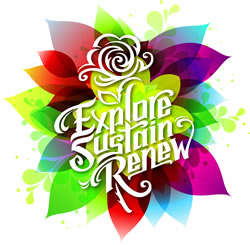 TESOL bloggers keep you up-to-date and posted on what's happening at the 2014 TESOL convention in Portland, Oregon, live! Read about what sessions they're attending, what the hot topics are this year, and what not to miss next year. Read More. TESOL bloggers keep you up-to-date and posted on what's happening at the 2014 TESOL convention in Portland, Oregon, live! Read about what sessions they're attending, what the hot topics are this year, and what not to miss next year. Read More.
|
|
ESL Games: Synonym Lingo Game, by Marc Anderson
 The Game: Synonym Lingo helps to build reading skills and vocabulary. The Game: Synonym Lingo helps to build reading skills and vocabulary.
Research Says: Using this game with ESL students much like other games for vocabulary presentation and revision, according to Agnieszka Uberman in the article “The Use of Games for Vocabulary. Read More. |
|
6 Ideas for Writing in the Real World, by Elena Shvidko
 Do your students feel uncomfortable writing in the real world? This is a fair concern, and in fact, I can definitely relate to that—when I started to learn English, I was afraid of making mistakes, which oftentimes made me quite anxious. I eventually overcame this fear with the help of my patient teachers and their authentic assignments that allowed me to practice English beyond the classroom. Do your students feel uncomfortable writing in the real world? This is a fair concern, and in fact, I can definitely relate to that—when I started to learn English, I was afraid of making mistakes, which oftentimes made me quite anxious. I eventually overcame this fear with the help of my patient teachers and their authentic assignments that allowed me to practice English beyond the classroom.
There are a whole variety of strategies and activities that could help your students write outside the classroom. I wanted to share some of them...Read More. |
|
Reflections From TESOL’s First Egyptian President: 10 Accomplishments and Lessons Learned, by Deena Boraie
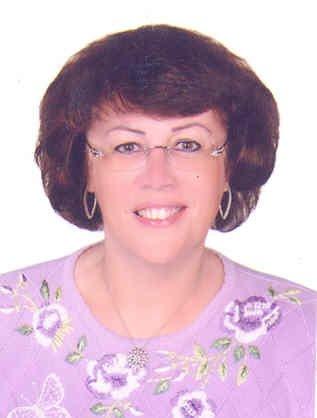 Time has flown—it seems like it was only yesterday when I was installed as TESOL president in Dallas in March 2013. It has been an amazing year! I was extremely busy; I learned a lot, did a lot, and loved it all. I reviewed what I wrote in the summer of 2011 on my election ballot and here are the three things I promised to do back then: Time has flown—it seems like it was only yesterday when I was installed as TESOL president in Dallas in March 2013. It has been an amazing year! I was extremely busy; I learned a lot, did a lot, and loved it all. I reviewed what I wrote in the summer of 2011 on my election ballot and here are the three things I promised to do back then:
- support the development and implementation of powerful professional learning opportunities for all TESOL members in a variety of contexts
- develop relationships and improve communication with all possible partners and organizations in support of TESOL’s efforts
- bridge research and practice to encourage research in TESOL to focus on the kinds of professional knowledge that teachers need.
Read More. |
TESOL Bookstore

Now It’s Easy to Assess Your English Language Learners
TESOL Press Books Can Help
NEW RELEASE! Assessing English Learners in U.S. Schools
Timothy L. Farnsworth and Margaret E. Malone
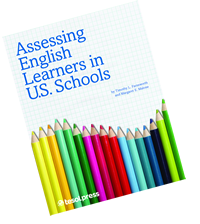 This book views teachers as the people best able to make their students successful. The decisions teachers make about assessments in the areas of literacy, oral language, and content-specific language development result in actionable information. Short reflections, jargon sidebars, and chapter activities make this an enjoyable, user-friendly resource for teachers in any classroom.
This book views teachers as the people best able to make their students successful. The decisions teachers make about assessments in the areas of literacy, oral language, and content-specific language development result in actionable information. Short reflections, jargon sidebars, and chapter activities make this an enjoyable, user-friendly resource for teachers in any classroom.
New Ways of Classroom Assessment, revised
James Dean Brown, Editor
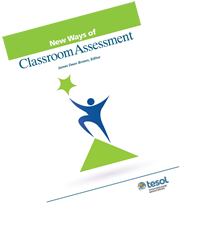 In this revised edition in the popular New Ways Series, teachers contributed activities whose aim was clearly to help their students. Consequently, more than 100 activities enlighten both students and teachers but are thoroughly integrated into the language teaching and learning processes and do not stand out as different, formal, threatening, or interruptive in the classroom.
In this revised edition in the popular New Ways Series, teachers contributed activities whose aim was clearly to help their students. Consequently, more than 100 activities enlighten both students and teachers but are thoroughly integrated into the language teaching and learning processes and do not stand out as different, formal, threatening, or interruptive in the classroom.
Assessment Practices
Christine Coombe and Nancy Hubley, Editors
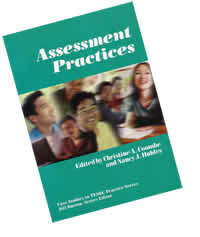 For language educators, teachers, and testers, these studies analyze assessment design, implementation, and review for classrooms, formal tests, programs, curricula, and self-assessment in global scenarios.
For language educators, teachers, and testers, these studies analyze assessment design, implementation, and review for classrooms, formal tests, programs, curricula, and self-assessment in global scenarios.